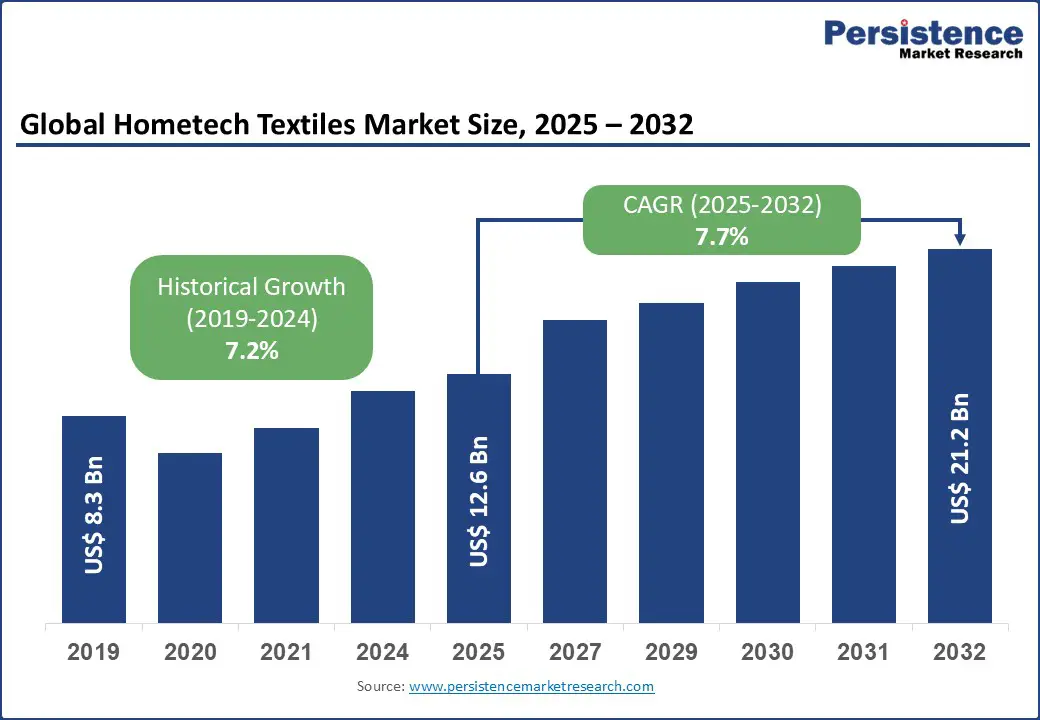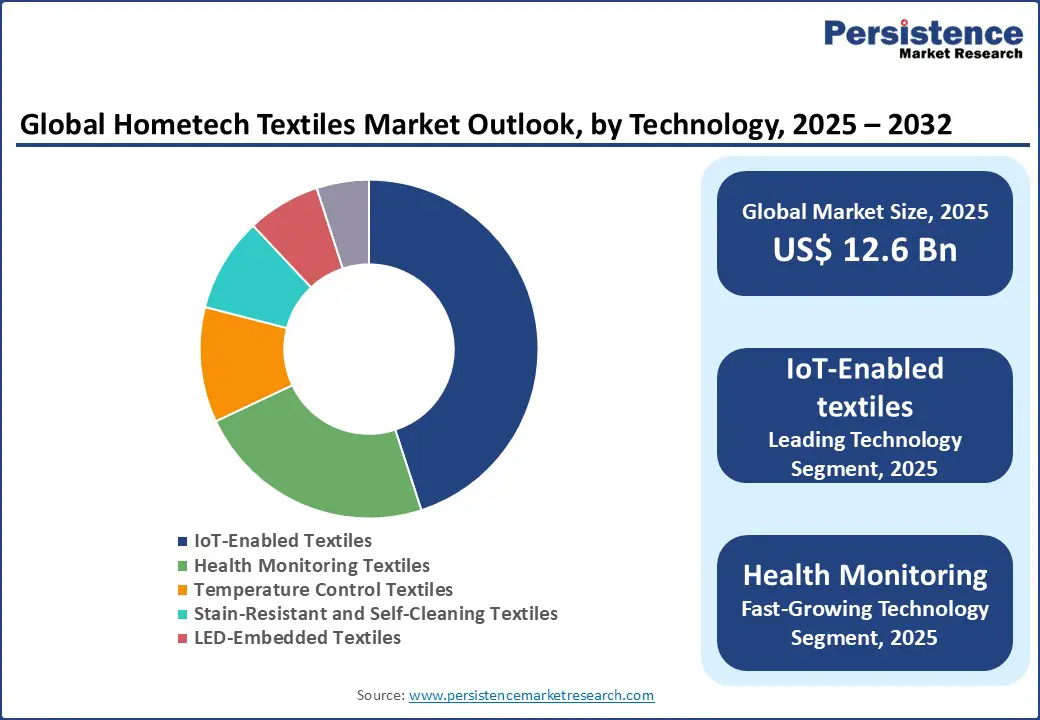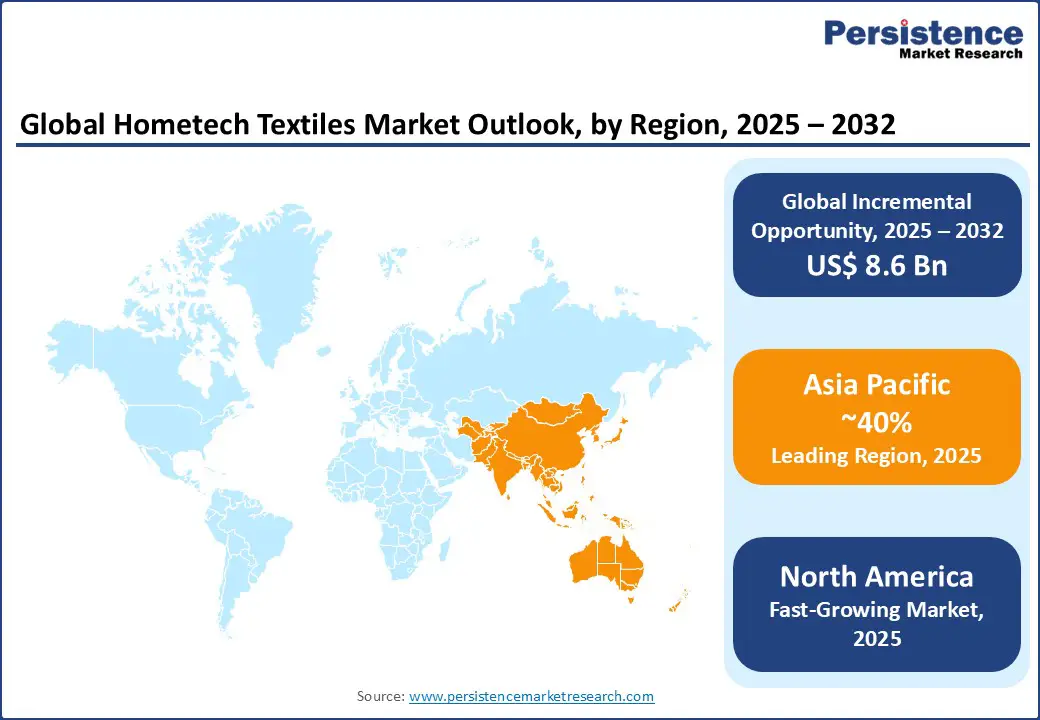ID: PMRREP8536| 188 Pages | 23 Sep 2025 | Format: PDF, Excel, PPT* | Chemicals and Materials

The global hometech textiles market size is likely to be valued at US$ 12.6 Bn in 2025 and is expected to reach US$ 21.2 Bn by 2032, growing at a CAGR of 7.7% during the forecast period from 2025 to 2032.
The hometech textiles market has witnessed substantial growth, driven by the increasing adoption of smart home technologies, rising consumer demand for functional and sustainable textiles, and advancements in textile manufacturing technologies.
Key Industry Highlights:

| Key Insights | Details |
|---|---|
| Hometech Textiles Market Size (2025E) | US$ 12.6 Bn |
| Market Value Forecast (2032F) | US$ 21.2 Bn |
| Projected Growth (CAGR 2025 to 2032) | 7.7% |
| Historical Market Growth (CAGR 2019 to 2024) | 7.2% |
The hometech textiles market is experiencing substantial growth, largely driven by the rising demand for smart home technologies. Consumers are increasingly adopting connected home ecosystems that integrate advanced devices for improved comfort, convenience, and energy efficiency.
Smart textiles, such as IoT-enabled bedding, upholstery, and curtains, play a pivotal role in these ecosystems by offering automated, responsive, and customizable features that enhance everyday living. The trend is particularly pronounced in developed regions such as North America and Europe, where high disposable income, a tech-savvy population, and a preference for premium home solutions fuel adoption.
In residential settings, smart textiles provide health-monitoring, temperature-regulating, and energy-efficient functionalities, making them highly attractive to households seeking convenience and well-being. In healthcare and assisted-living environments, these textiles enable continuous monitoring of patient health, integration with medical devices, and personalized comfort, driving demand further.
The growth of home automation platforms, widespread use of smartphones and voice-controlled devices, and consumer preference for sustainable and multifunctional products are accelerating the adoption of smart home textiles.
The high development and production costs associated with smart and IoT-enabled textiles. Developing these advanced textiles requires significant investment in research and development (R&D) to integrate electronic components, sensors, and connectivity features into conventional fabrics without compromising comfort and durability. Manufacturing smart textiles also involves sophisticated production techniques, specialized machinery, and skilled labor, which increase operational expenses.
By adding energy-harvesting capabilities, health-monitoring sensors, and sustainable materials further elevates costs, making the final products more expensive than traditional home textiles. This can limit adoption, particularly in price-sensitive regions or among mid-market consumers.
Companies must also invest in regulatory compliance, quality testing, and technology integration, adding to the overall development cost. These high costs can slow down market penetration and affect profitability, especially for small and medium-sized manufacturers competing with established global players. As a result, while the industry is growing rapidly, cost constraints remain a significant barrier that companies need to overcome through innovation, economies of scale, and strategic partnerships.
The hometech textiles market is witnessing significant growth due to advancements in sustainable and energy-harvesting textiles. These innovations allow textiles to generate and store energy from ambient sources such as body movement, sunlight, or heat, reducing dependence on external power sources.
For instance, wearable fabrics have been developed that convert body motion into electricity, enabling applications in health monitoring, sports performance tracking, and medical devices. Similarly, smart photovoltaic textiles integrate solar cells into fabrics, allowing garments and home textiles to be self-powered.
Sustainability is a critical driver, as companies are increasingly focusing on biodegradable sensors, recyclable conductive materials, and eco-friendly fibers to meet growing consumer demand for environmentally responsible products.
These advancements create opportunities for multifunctional textiles in residential, healthcare, and hospitality applications, enabling energy efficiency, comfort, and automation. By leveraging energy-harvesting and sustainable technologies, manufacturers can enhance product value while supporting environmental goals, positioning this segment as a key growth driver in the hometech textiles market.
Smart bedding dominates the hometech textiles market, expected to account for approximately 35% share in 2025. Its dominance is attributed to its widespread adoption in residential and healthcare settings, where features like temperature regulation, sleep tracking, and health monitoring enhance user comfort and well-being. Smart bedding products, integrate IoT sensors and temperature control technologies, enabling real-time adjustments and seamless integration with smart home systems.
The smart clothing segment is the fastest-growing, driven by increasing demand in sports, fitness, and healthcare applications. Smart clothing, embedded with health-monitoring and energy-harvesting technologies, offers real-time data on vital signs, making it ideal for athletes and patients with chronic conditions. The growing popularity of wearable technology is accelerating the adoption of smart clothing, particularly in North America and the Asia Pacific.
IoT-Enabled textiles lead, holding a 45% share in 2025. Their dominance is driven by the need for connected, automated textile solutions that integrate with smart home ecosystems and provide user-friendly functionality. IoT-enabled textiles, such as smart curtains and bedding, allow remote control and real-time monitoring, enhancing convenience and energy efficiency. Companies like DuPont and TWE Group are pioneering IoT textile solutions for residential and commercial applications.
The health monitoring textiles segment is the fastest-growing, fueled by rising demand in the healthcare and sports sectors. These textiles, embedded with sensors to track heart rate, respiratory rate, and other vital signs, are increasingly used in hospitals and fitness wearables. The global healthcare wearable market is driving demand for health-monitoring textiles, particularly in Europe and the Asia Pacific.
Residential applications lead the hometech textiles market, accounting for approximately 42% of revenue in 2025. The segment’s dominance is driven by the growing adoption of smart home technologies, such as IoT-enabled curtains, bedding, and upholstery, which enhance comfort and energy efficiency. Residential consumers prioritize convenience and sustainability, making smart textiles a key component of modern homes.
The healthcare facilities segment is the fastest-growing, driven by the increasing use of health-monitoring and antimicrobial textiles in hospitals and clinics. The rise in chronic diseases and aging populations, particularly in North America and Europe, has spurred demand for smart bedding and clothing that support patient monitoring and infection control. The global healthcare textiles market is further boosting this segment.

The hometech textiles market in North America is witnessing steady growth, fueled by advanced research and development (R&D), high consumer demand, and the widespread adoption of smart home technologies.
The region benefits from well-established technology infrastructure, enabling the integration of IoT-enabled textiles, smart bedding, and automated home fabrics into connected home ecosystems. Consumers increasingly prefer premium and multifunctional home textiles that provide comfort, convenience, and health-monitoring capabilities, driving demand across residential and healthcare sectors.
The United States and Canada are leading contributors, supported by high disposable incomes, tech-savvy populations, and growing awareness of energy-efficient and sustainable home solutions. Companies in the region are heavily investing in innovative product development, strategic partnerships, and collaborations with smart home and healthcare providers, enabling them to deliver advanced textile solutions with enhanced functionality.
Moreover, the adoption of voice-controlled devices, mobile applications, and home automation platforms is accelerating the penetration of smart textiles in households. Healthcare facilities and assisted-living centers are also leveraging these technologies for patient monitoring, comfort, and safety. Collectively, these factors ensure that North America holds a significant market share while continuing to innovate in smart textile applications.
Europe is a significant player in the hometech textiles market, driven by strong institutional support and consumer demand for sustainable textiles. Leading countries, such as Germany, France, and the UK, are investing heavily in smart textile R&D through initiatives like the EU’s Horizon Europe program. Companies like Freudenberg and Ahlstrom Corporation are developing advanced IoT-enabled and energy-harvesting textiles for residential and healthcare applications.
Germany’s focus on Industry 4.0 and smart manufacturing supports the integration of AI and IoT in textiles, while France’s hospitality sector drives demand for smart upholstery and curtains. The UK’s emphasis on sustainability, backed by policies like the Net Zero Strategy, is accelerating the adoption of eco-friendly textiles. Europe’s growing healthcare sector further boosts demand for health-monitoring textiles, ensuring steady market growth.
Asia Pacific holds a dominant 40% share of the global hometech textiles market, making it the leading region. This growth is driven by rapid urbanization, which is fueling residential construction and increasing demand for modern home solutions. Rising technological adoption is another key factor, as consumers increasingly embrace IoT-enabled, energy-harvesting, and smart home textiles for comfort, convenience, and health monitoring.
Sustainability trends are also influencing market dynamics, with manufacturers focusing on eco-friendly fibers, biodegradable sensors, and multifunctional textiles to meet consumer demand for environmentally responsible products.
Countries such as China, India, Japan, and South Korea are spearheading growth due to their strong manufacturing base, increasing disposable incomes, and government initiatives promoting innovation. These factors collectively establish Asia Pacific as a strategic hub for hometech textile development.

The global hometech textiles market is characterized by intense competition, driven by technological innovation and regional strengths. In developed regions like North America and Europe, large firms such as DuPont, Polymer Group Inc., and Freudenberg dominate through advanced R&D capabilities and partnerships with smart home and healthcare providers. In the Asia Pacific, rapid market growth is attracting investments from both global players like Ahlstrom Corporation and regional vendors.
Companies are focusing on product innovation, sustainable materials, and strategic collaborations to gain a competitive edge. The development of IoT-enabled and energy-harvesting textiles has emerged as a key differentiator, enabling faster adoption in residential and healthcare sectors.
The sector exhibits a mix of consolidation and fragmentation: while global giants drive consolidation through mergers, acquisitions, and strategic alliances, numerous small and regional players maintain a fragmented landscape catering to niche demands and local preferences. Strategic acquisitions, partnerships with tech firms, and digital-first marketing approaches are further intensifying the competitive dynamics.
The global hometech textiles market is projected to reach US$ 12.6 Bn in 2025.
The increasing adoption of smart home technologies is a key driver.
The hometech textiles market is poised to witness a CAGR of 7.7% from 2025 to 2032.
Advancements in sustainable and energy-harvesting textiles are a key opportunity.
Polymer Group Inc., Freudenberg, TWE Group, Ahlstrom Corporation, DuPont Chemicals, and Aadinath Hometech are key players.
| Report Attribute | Details |
|---|---|
| Historical Data/Actuals | 2019 - 2024 |
| Forecast Period | 2025 - 2032 |
| Market Analysis | Value: US$ Bn, Volume: As Applicable |
| Geographical Coverage |
|
| Segmental Coverage |
|
| Competitive Analysis |
|
| Report Highlights |
|
By Product Type
By Technology
By End-use
By Region
Delivery Timelines
For more information on this report and its delivery timelines please get in touch with our sales team.
About Author